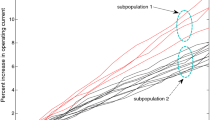Abstract
Influence of covariates on degradationis modelled. Models which include dependence of the intensityof the process of traumatic events on the degradation level arealso discussed. Estimation of reliability and degradation characteristicsfrom data with covariates is considered in dynamic environments.
Similar content being viewed by others
References
W. Achtziger, M. P. Bendsøe, and J. E. Taylor, “Bounds on the effect of progressive structural degradation,” J. Mech. Phys. Solids 46,6 pp. 1055–1087, 1998.
V. Bagdonavičius, “Testing the hypothesis of the additive accumulation of damages,” Probab. Theory and its Appl. 23, pp. 403–408, 1978.
V. Bagdonavičius and M. Nikulin, “Model building in accelerated experiments,” in Statistical and Probabilistic Models in Reliability, (D. Ionescu and N. Limnios, eds.), Birkhauser, pp. 51–74, 1999a.
V. Bagdonavičius and M. Nikulin, “Estimation in degradation models with explanatory variables,” Technical Report 9903, Statistique Mathématique, Université Bordeaux 2, 17pp., 1999b.
V. Bagdonavičius and M. Nikulin, “Statistical analysis of degradation data in dynamic environment,” Dipartamento di Matematica “Guido Castenuovo”, Universtá degli Studi di Roma “La Sapienza”, 20 pp., 2000a. Preprint 21/00.
V. Bagdonavičius and M. Nikulin, “Semiparametric estimation in accelerated life testing,” in Recent Advances in Reliability Theory, (N. Limnios and M. Nikulin, eds.), Birkhauser, pp. 405–430, 2000b.
M. Boulanger and L. A. Escobar, “Experimental design for a class of accelerated degradation tests,” Technometrics, 36, pp. 260–272, 1994.
M. B. Carey and R. H. Koenig. “Reliability assessment based on accelerated degradation: A case study,” IEEE Transactions on Reliability, 40, pp. 499–506, 1991.
C. H. Chiao and M. Hamada. “Using degradation data from an experimet to achive robust reliability for light emmitining diodes,” Quality and Reliability Engineering International, 12, pp. 89–94, 1996.
E. Cinlar, “On a generalization of gamma processes,” J. Appl. Probab., 17, pp. 467–480, 1980.
D. R. Cox, “Some remarks on failure-times, surrogate markers, degradation, wear, and the quality of life,” Lifetime Data Analysis, 5, pp. 307–314, 1999.
N. E. Dowling, Mechanical Behavior of Materials, Prentice Hall: Englewood Cliffs, 1993.
K. A. Doksum and A. Hoyland, “Models for variable-stress accelerated life testing experiment based on Wiener processes and the inverse Gaussian distribution,” Technometrics, 34, pp. 74–82, 1992.
K. A. Doksum and S.-L. T. Normand, “Gaussian models for degradation processes–part I: Methods for the analysis of biomarker data,” Lifetime Data Analysis, 1, pp. 131–144, 1995.
D. P. Gaver, “Random hazard in reliability problems,” Technometrics, 5, pp. 211–226, 1963.
M. Hamada, “Analysis of experiments for reliability improvement and robust reliability,” in Recent Advances in Life-Testing and Reliability, (N. Balakrishnan, ed.), CRC Press: Boca Raton, 1995.
D. J. Klinger, “Failure time and rate constant of degradation: An argument for the inverse relationship,” Microelectronics and Reliability, 32, pp. 987–994, 1992.
J. Lawless, J. Hu, and J. Cao, “Methods for the estimation of failure distributions and rates from automobile warranty data,” Lifetime Data Analysis, 1, pp. 227–240, 1995.
C. J. Lu, “Degradation processes and related reliability models,” Ph.D. thesis, McGill University, Montreal, Canada, 1995.
C. J. Lu and W. Q. Meeker, “Using degradation measures to estimate a time-to-failure distribution,” Technometrics, 35, pp. 161–174, 1993.
W. Q. Meeker, L.A. Escobar, and C. J. Lu, “Accelerated degradation tests: Modeling and analysis,” Technometrics, 40, pp. 89–99, 1998.
W. Q. Meeker and L. A. Escobar, Statistical Methods for Reliability Data, John Wiley and Sons: New York, 1998.
F. Mitsuo, Reliability and Degradation of Semiconductor Lasers and LED, Artech House: Norwood, 1991.
W. Nelson, Accelerated Testing: Statistical Models, Test Plans, and Data Analysis, John Wiley and Sons: New York, 1990.
N. D. Singpurwalla, “Survival in dynamic environnements,” Statistical Science, l,10, pp. 86–103, 1995.
N. D. Singpurwalla, “Gamma processes and their generalizations: An overview ”, in Engineering Probabilistic Design and Maintenance for Flood Protection (R. Cook, M. Mendel, and H. Vrijling, eds.), Kluwer Acd. Publishers, pp. 67–73, 1997.
N. D. Singpurwalla and M. A. Youngren, “Multivariate distributions induced by dynamic environments,” Scandinavian Journal of Statistics, 20, pp. 251–261, 1998.
K. Suzuki, K. Maki, and S. Yokogawa, “An analysis of degradation data of a carbon film and properties of the estimators,” in Statistical Sciences and Data Analysis, (K. Matusita, M. Puri, and T. Hayakawa, eds.), Utrecht Netherlands: VSP, 1993.
S. T. Tseng, M. S. Hamada, and C. H. Chiao, “Using Degradation Data from a Fractional Experiment to Improve Fluorescent Lamp Reliability,” The Institute for Improvement in Quality and Productivity, University of Waterloo, Waterloo, Ontario, Canada, Research Report RR-94-05, 1994.
G. A. Whitmore, “Estimating degradation by a Wiener diffusion process subject to measurement error,” Lifetime Data Analysis, 1, pp. 307–319, 1995.
G. A. Whitmore and F. Schenkelberg, “Modelling accelerated degradation data using Wiener diffusion with a time scale transformation,” Lifetime Data Analysis, 3, pp. 27–45, 1997.
G. A. Whitmore, M. I. Crowder, and J. F. Lawless, “Failure inference from a marker process based on bivariate model,” Lifetime Data Analysis, 4, pp. 229–251, 1998.
T. Yanagisava, “Estimation of the degradation of amorphous silicon cells,” Microelectronics and Reliability, 37, pp. 549–554, 1997.
Author information
Authors and Affiliations
Rights and permissions
About this article
Cite this article
Bagdonavicius, V., Nikulin, M.S. Estimation in Degradation Models with Explanatory Variables. Lifetime Data Anal 7, 85–103 (2001). https://doi.org/10.1023/A:1009629311100
Issue Date:
DOI: https://doi.org/10.1023/A:1009629311100




